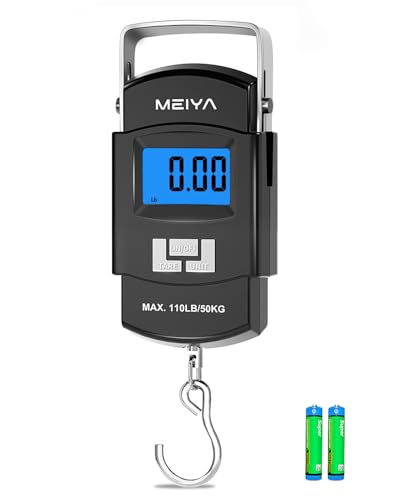I love it. The gorge section downstream from the Camp Peniel Bridge is picture perfect trout water.
I was worried about Big Hunting when I looked at the map. As you can see, the road runs right next to the stream. This typically means that it is heavily pressured, the climate and ambiance destroyed and a visit will be a waste of time. What saves this water are three things:
- It’s actually a bit physical to work the gorge section
- Catch and Release
- Fly Fishing Only
While you can park at several different pulloffs in the gorge stretch of the river, there are plenty of large rocks, steep inclines and tricky footwork required to get from spot to spot. On my day there, I did a complete “drive by” recon up past the Cunningham Falls State Park. I scouted up the road past the dam and lake to see what the creek looked like at the high end.
Don’t bother. This is very skinny water as you can see from the first picture below. The lake looks great. I did not stop to really take a hard look at it, but there appears to be plenty of parking and only a few people working the banks on this Saturday morning, I did not see any canoes or boats – something that I will keep in mind when I need to get the Basswife back out on the water.
Given the lack of interesting water around the lake, I drove back down 77 in search of a pulloff. I figured that since I did not know the area, any pulloff would work just fine. After passing the handicap only parking section, I pulled in and rigged up at the top of the red line on the map. After a quick walk to the creek to check it out, I decided to go with my 4wt rod and a 2 lb test tippet since the water was not very watery at this point.
I was not impressed with the creek where I parked. It was fairly shallow and the nymphs I put on were snagged constantly on the bottom. Regardless, I stuck with them as I worked my way quickly down to the Camp Peniel bridge. Even though this was early in the morning the hikers were out and using the trail that follows the creek. Of course, there were several parked on rocks at the best pools. Guess if the pool will hold trout, it will attract hikers as well. That caused me to quickly blow by this section and investigate the water below the bridge. There was a guy fishing in the section near the Camp, so I skipped down another 50 yards to give him some space.
Wow. This was nice water, The gorge takes a deep dip right here and there are plenty of plunge pools, small runs and boulders perfect for holding trout. I continued to use my nymph rig with no luck. As a new fly guy, I’m still a bit confused about what and when. But, it was clear to me that the water was too small for streamers given my lack of tight water casting skills, so I decided that if I could not float nymphs, I would float something on the top of the water and allow the current to work its magic. After all, I was working downstream.
With Gelso and Coburn’s guidance from Guide to Maryland Trout Fishing in mind, I adopted a stealth approach as I moved to the next likely spot. With only my head and shoulders above the rock, I gently flipped a grasshopper pattern into the current. It drifted into a bundle of sticks and got hung up. Dang. With a few inept tugs, I got lucky and started the second drift a bit farther to the left. BANG! A nice 14″ brook welcomed me to Big Hunting Creek and confirmed its promise of active, nasty fighters. It took about a minute to move him close enough to where I could gently hand land him and snap a picture. This was going to be a great day!
I ran into another fisherman just then and we chatted a bit. He had started about 100 yards down from where we were and was using an Adams. No luck so far. I showed him the pattern I was using (a variation of “Dave’s Hopper”) and wished him luck as he worked his way upstream.
Since he had just hit the section below me, I skipped down about 50 yards and found another nice pool. This was as good a place as any, I pretty much low crawled up to the stream – hands and knees, propped myself up behind a rock and started working it again. There were a bunch of little brown insects fluttering around. Since I am not experienced enough to actually know what they were, I tied on several different small brown looking flies in an attempt to mimic them since the trout in this pool were feeding on the top.
No luck. I finally put on a black gnat thinking the variation would attract attention and that did the trick! Got another nice fish. But, no more luck in this pool. In fact, I realized that I could see the pod of trout watching me as I worked it. Some of them were clearly making snide remarks, so I decided to move on and move back to the hopper pattern.
Several pools down, I did another low key approach from upstream. Walking slowly and hunched to plop down on a rock in perfect alignment with the slot on a nice big pool. I started working this with the hopper and, on the third run was startled as the water exploded to my front. But, I was able to set the hook and a few minutes later land the reward – another fat, reasonably large brook. This pool produced another 4 just like it. I must have worked that pool for 45 minutes from different angles – this is the key difference I am discovering between spin and fly. With fly, you can be patient and work. With spin, the water is torn up, the pool is disturbed and you need to move on fairly quickly.

Red line marks my fishing trail. The graph below shows the vertical gain over the hike. The graph looks dramatic only because it is 3/4 mile squished into a small space. Total vertical was only 188 feet.
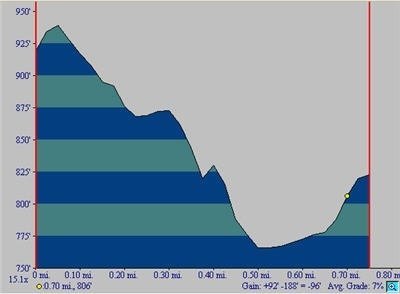
After the last brookie gulped down the hopper, I decided it was time to move and try that hopper lucky charm on the next spot. Sadly, on the next pool, the hopper got hung up in a place that was out of reach. Rats. That was my last one of that pattern. Next time I am back at Bass Pro Shops in Arundel, I’ll pick up a handful. The hopper was in pretty pitful shape at that point anyway. He was missing a leg and most of his antennae from the mauling he got with the voracious brookies.
I wanted to hit Owens Creek in the afternoon, so I decided this was a good time to call it a day here and move on. I did have to go look around the next bend… can’t just leave… and was rewarded with the view of more enticing water below.
So. Back to the real point. This is good water even though it is near the road because it is clear that those of us who use it are gentle on the resource. In spite of heavy pressure (I saw at least 5 other folks while I was there), the fish persist. Catch and release is the key – which when coupled with the fly fishing ethic – makes this body of water a real success story regarding resource management. Mix in a little sweat and you have the perfect combination of factors that should protect this treasure in the future. That combination of characteristics caused me to rate this water as “GREEN” in spite of some shortcomings. It’s not remote, it’s not hard to get to and you do not need to be in top shape to enjoy it. But… it’s a great place to spend a day.
Getting There: Mapquest yourself to Thurmont, MD. In Thurmont, exit on 77N. The road picks up the creek on the right after about a mile and you enter the park soon after that.
Update based on feedback: I need to spend more time investigating the upper end of the stream. I received feedback on the orginal posting of this that the wild brown trout reproduce well above the Dam and that the water up there does indeed support them. Here’s the facts: “According to MD DNR, during the last ten years (1992-2001), the mean brown trout found have ranged from 110 pounds/acre above Cunningham Falls lake to 68 pounds/acre in the tailwater (that’s below the reservoir where you fished). So you see, the area above is a much better wild trout fishery.”
The Friends of Big Hunting Creek stocked the water with brook trout this March and May of this year. They did not include either Rainbows or Browns.
I really appreciate this additional information so I can make the trip report more accurate and useful. Thanks!
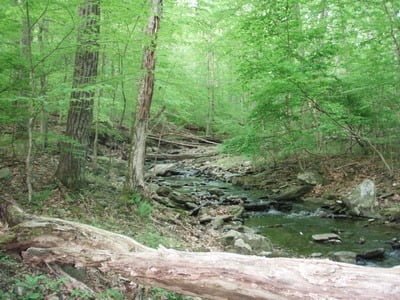
Taken at waypoint 001 on the map – not much here above the lake.
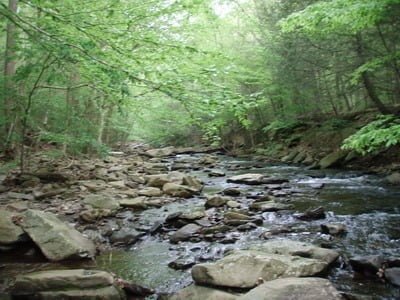
The river runs wide in the flat area. This was taken at the top of the red line; looking upstream
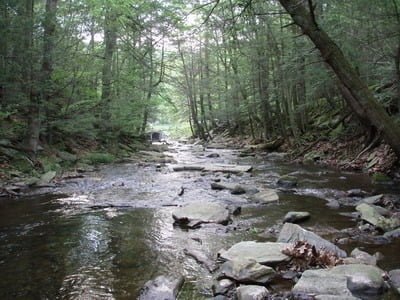
Looking downstream to the Camp Peniel bridge – that’s where the better water starts. You can see the bridge in the distance.
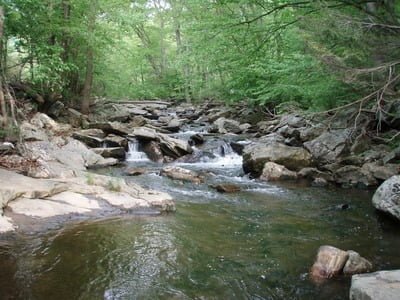
After the bridge, the land pitches down and creates good pocket water and runs
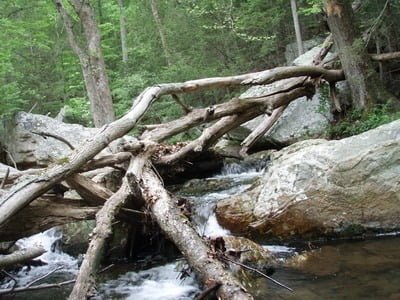
Even though it is by the road, it’s tough climbing in spots – need a bit of physical capability
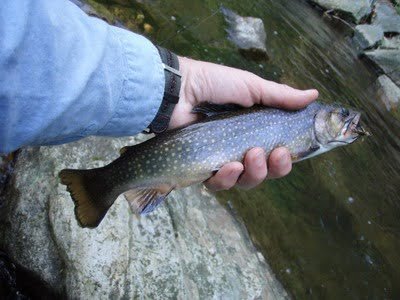
First fish of the day on a Dave’s Hopper type pattern. They hammered this pattern all day – banging the legs off it.
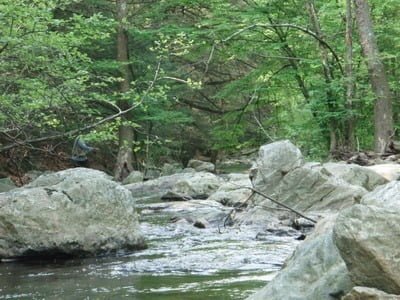
At the bend, the terrain flattens a bit, but there are plenty of boulders to make the water interesting.
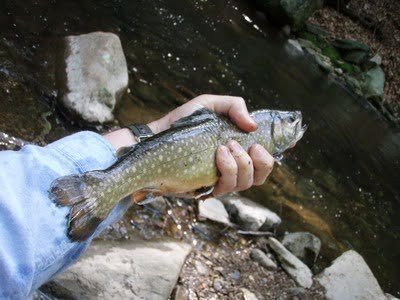
Another nice trout on the Dave’s Hopper pattern
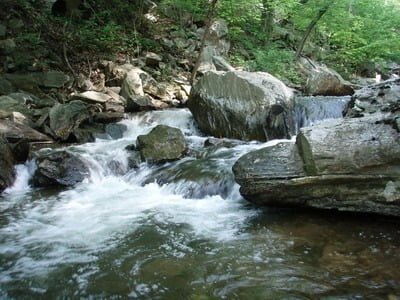
Pretty, pretty water. Not as crowded as Gunpowder for water so near to the DC area. I did see 5 other folks fishing this section with me.
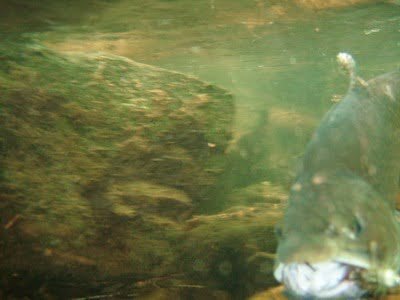
Underwater shot of one of the trout before I unhooked him
Unless stated otherwise, this article was authored by Steve Moore


